
A | B | C | D | E | F | G | H | CH | I | J | K | L | M | N | O | P | Q | R | S | T | U | V | W | X | Y | Z | 0 | 1 | 2 | 3 | 4 | 5 | 6 | 7 | 8 | 9
| Beluga whale[1] Temporal range:
| |
|---|---|

| |
| At City of Arts and Sciences, Spain | |

| |
| Size compared to an average human | |
| Scientific classification | |
| Domain: | Eukaryota |
| Kingdom: | Animalia |
| Phylum: | Chordata |
| Class: | Mammalia |
| Order: | Artiodactyla |
| Infraorder: | Cetacea |
| Family: | Monodontidae |
| Genus: | Delphinapterus Lacépède, 1804 |
| Species: | D. leucas
|
| Binomial name | |
| Delphinapterus leucas (Pallas, 1776)
| |

| |
| Beluga range | |
The beluga whale (/bɪˈluːɡə/;[4] Delphinapterus leucas) is an Arctic and sub-Arctic cetacean. It is one of two members of the family Monodontidae, along with the narwhal, and the only member of the genus Delphinapterus. It is also known as the white whale, as it is the only cetacean to regularly occur with this colour; the sea canary, due to its high-pitched calls; and the melonhead, though that more commonly refers to the melon-headed whale, which is an oceanic dolphin.
The beluga is adapted to life in the Arctic, with anatomical and physiological characteristics that differentiate it from other cetaceans. Amongst these are its all-white colour and the absence of a dorsal fin, which allows it to swim under ice with ease.[5] It possesses a distinctive protuberance at the front of its head which houses an echolocation organ called the melon, which in this species is large and deformable. The beluga's body size is between that of a dolphin and a true whale, with males growing up to 5.5 m (18 ft) long and weighing up to 1,600 kg (3,530 lb). This whale has a stocky body. Like many cetaceans, a large percentage of its weight is blubber (subcutaneous fat). Its sense of hearing is highly developed and its echolocation allows it to move about and find breathing holes under sheet ice.
Belugas are gregarious and form groups of 10 animals on average, although during the summer, they can gather in the hundreds or even thousands in estuaries and shallow coastal areas. They are slow swimmers, but can dive to 700 m (2,300 ft) below the surface. They are opportunistic feeders and their diets vary according to their locations and the season. The majority of belugas live in the Arctic Ocean and the seas and coasts around North America, Russia, and Greenland; their worldwide population is thought to number around 200,000.[6][7] They are migratory and the majority of groups spend the winter around the Arctic ice cap; when the sea ice melts in summer, they move to warmer river estuaries and coastal areas. Some populations are sedentary and do not migrate over great distances during the year.
The native peoples of North America and Russia have hunted belugas for many centuries. They were also hunted by non-natives during the 19th century and part of the 20th century. Hunting of belugas is not controlled by the International Whaling Commission, and each country has developed its own regulations in different years. Currently, some Inuit in Canada and Greenland, Alaska Native groups and Russians are allowed to hunt belugas for consumption as well as for sale, as aboriginal whaling is excluded from the International Whaling Commission 1986 moratorium on hunting. The numbers have dropped substantially in Russia and Greenland, but not in Alaska and Canada. Other threats include natural predators (polar bears and killer whales), contamination of rivers (as with Polychlorinated biphenyl (PCBs) which bioaccumulate up the food chain), climate change and infectious diseases. The beluga was placed on the International Union for Conservation of Nature's Red List in 2008 as being "near threatened"; the subpopulation from the Cook Inlet in Alaska, however, is considered critically endangered and is under the protection of the United States' Endangered Species Act. Of all seven extant Canadian beluga populations, those inhabiting eastern Hudson Bay, Ungava Bay, and the St. Lawrence River are listed as endangered.
Belugas are one of the most commonly kept cetaceans in captivity and are housed in aquariums, dolphinariums and wildlife parks in North America, Europe and Asia. They are considered charismatic because of their docile demeanour and characteristic smile, communicative nature,[8] and supple, graceful movement.[9]
Taxonomy

The beluga was first described in 1776 by Peter Simon Pallas.[1] It is a member of the family Monodontidae, which is in turn part of the parvorder Odontoceti (toothed whales).[1] The Irrawaddy dolphin was once placed in the same family, though recent genetic evidence suggests these dolphins belong to the family Delphinidae.[10][11] The narwhal is the only other species within the Monodontidae besides the beluga.[12] A skull has been discovered with intermediate characteristics supporting the hypothesis that hybridisation is possible between these two species.[13]
The name of the genus, Delphinapterus, means "dolphin without fin" (from the Greek δελφίν (delphin), dolphin and απτερος (apteros), without fin) and the species name leucas means "white" (from the Greek λευκας (leukas), white).[14] The Red List of Threatened Species gives both beluga and white whale as common names, though the former is now more popular. The English name comes from the Russian белу́га, which derives from the word белый (bélyj), meaning "white".[14] Nowadays the word белу́га in Russian refers to the beluga sturgeon, while the whale is called almost similarly - белу́ха ("belúha").[citation needed]
The whale is also colloquially known as the "sea canary" on account of its high-pitched squeaks, squeals, clucks, and whistles. A Japanese researcher claimed that he taught a beluga to "talk" by using these sounds to identify three different objects, offering hope that humans may one day be able to communicate effectively with sea mammals.[15] A similar observation has been made by Canadian researchers, where a beluga which died in 2007 "talked" when he was still a subadult. Another example is NOC, a beluga whale that could mimic the rhythm and tone of human language. Beluga whales in the wild have been reported to imitate human voices.[16]
Evolution

Mitochondrial DNA studies have shown modern cetaceans last shared a common ancestor between 25 and 34 million years ago[17][18] The superfamily Delphinoidea (which contains monodontids, dolphins and porpoises) split from other toothed whales, odontoceti, between 11 and 15 million years ago. Monodontids then split from dolphins (Delphinidae) and later from porpoises (Phocoenidae), their closest relatives in evolutionary terms.[17] In 2017 the genome of a beluga whale was sequenced, comprising 2.327 Gbp of assembled genomic sequence that encoded 29,581 predicted genes.[19] The authors estimated that the genome-wide sequence similarity between beluga whales and killer whales is 97.87%.[citation needed]
The beluga's earliest known distinctive ancestors include the prehistoric Denebola brachycephala from the late Miocene epoch (9–10 million years ago),[20][21] and Bohaskaia monodontoides, from the early Pliocene (3–5 million years ago).[22] Fossil evidence from Baja California[23] and Virginia indicate the family once inhabited warmer waters.[22] A fossil of the monodontid Casatia thermophila, from five million years ago, provides the strongest evidence that monodontids once inhabited warmer waters, as the fossil was found alongside fossils of tropical species such as bull and tiger sharks.[24]
The fossil record also indicates that, in comparatively recent times, the beluga's range varied with that of the polar ice packs expanding during ice ages and contracting when the ice retreated.[25] Counter-evidence to this theory comes from the finding in 1849 of fossilised beluga bones in Vermont in the United States, 240 km (150 mi) from the Atlantic Ocean. The bones were discovered during construction of the first railroad between Rutland and Burlington in Vermont, when workers unearthed the bones of a mysterious animal in Charlotte. Buried nearly 10 ft (3.0 m) below the surface in a thick blue clay, these bones were unlike those of any animal previously discovered in Vermont. Experts identified the bones as those of a beluga. Because Charlotte is over 150 mi (240 km) from the nearest ocean, early naturalists were at a loss to explain the presence of the bones of a marine mammal buried beneath the fields of rural Vermont.[citation needed]
The remains were found to be preserved in the sediments of the Champlain Sea, an extension of the Atlantic Ocean within the continent resulting from the rise in sea level at the end of the ice ages some 12,000 years ago.[26] Today, the Charlotte whale is the official Vermont State Fossil (making Vermont the only state whose official fossil is that of a still extant animal).[27]

Description

Its body is round, particularly when well fed, and tapers less smoothly to the head than the tail. The sudden tapering to the base of its neck gives it the appearance of shoulders, unique among cetaceans. The tail-fin grows and becomes increasingly and ornately curved as the animal ages. The flippers are broad and short—making them almost square-shaped.
Longevity
Preliminary investigations suggested a beluga's life expectancy was rarely more than 30 years.[28] The method used to calculate the age of a beluga is based on counting the layers of dentin and dental cement in a specimen's teeth, which were originally thought to be deposited once or twice a year. The layers can be readily identified as one layer consists of opaque dense material and the other is transparent and less dense. It is therefore possible to estimate the age of the individual by extrapolating the number of layers identified and the estimated frequency with which the deposits are laid down.[29] A 2006 study using radiocarbon dating of the dentin layers showed the deposit of this material occurs with a lesser frequency (once per year) than was previously thought. The study therefore estimated belugas can live for 70 or 80 years.[30] However, recent studies suggest that it is unclear as to whether belugas receive a different number of layers per year depending on the age of the animal (for example young belugas may only receive an additional one layer per year), or simply just one layer per year or every other year.[31][citation needed]
Size
The species presents a moderate degree of sexual dimorphism, as the males are 25% longer than the females and are sturdier.[32] Adult male belugas can range from 3.5 to 5.5 m (11 to 18 ft), while the females measure 3 to 4.1 m (9.8 to 13.5 ft).[33] Males weigh between 1,100 and 1,600 kg (2,430 and 3,530 lb), and occasionally up to 1,900 kg (4,190 lb) while females weigh between 700 and 1,200 kg (1,540 and 2,650 lb).[34][35] They rank as mid-sized species among toothed whales.[36]
Individuals of both sexes reach their maximum size by the time they are 10 years old.[37] The beluga's body shape is stocky and fusiform (cone-shaped with the point facing backwards), and they frequently have folds of fat, particularly along the ventral surface.[38] Between 40% and 50% of their body weight is fat, which is a higher proportion than for cetaceans that do not inhabit the Arctic, where fat only represents 30% of body weight.[39][40] The fat forms a layer that covers all of the body except the head, and it can be up to 15 cm (5.9 in) thick. It acts as insulation in waters with temperatures between 0 and 18 °C, as well as being an important reserve during periods without food.[41]
Colour
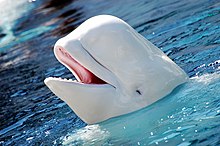
The adult beluga is rarely mistaken for any other species, because it is completely white or whitish-grey in colour.[42] Calves are usually born grey,[33] and by the time they are a month old, have turned dark grey or blue grey. They then start to progressively lose their pigmentation until they attain their distinctive white colouration, at the age of seven years in females and nine in males.[42] The white colouration of the skin is an adaptation to life in the Arctic that allows belugas to camouflage themselves in the polar ice caps as protection against their main predators, polar bears and killer whales.[43] Unlike other cetaceans, the belugas seasonally shed their skin.[44] During the winter, the epidermis thickens and the skin can become yellowish, mainly on the back and fins. When they migrate to the estuaries during the summer, they rub themselves on the gravel of the riverbeds to remove the cutaneous covering.[44]
Head and neck
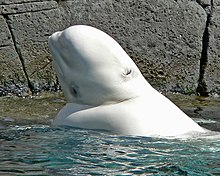
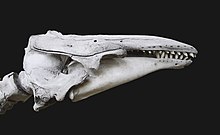
Like most toothed whales, the beluga has a compartment found at the centre of the forehead that contains an organ used for echolocation called a melon, which contains fatty tissue.[45] The shape of the beluga's head is unlike that of any other cetacean, as the melon is extremely bulbous, lobed and visible as a large frontal prominence.[45] Another distinctive characteristic it possesses is the melon is malleable; its shape is changed during the emission of sounds.[12] The beluga is able to change the shape of its head by blowing air around its sinuses to focus the emitted sounds.[46][47] This organ contains fatty acids, mainly isovaleric acid (60.1%) and long-chain branched acids (16.9%), a very different composition from its body fat, and which could play a role in its echolocation system.[48]

Unlike many dolphins and whales, the seven vertebrae in the neck are not fused together, allowing the animal to turn its head laterally without needing to rotate its body.[49] This gives the head a lateral manoeuvrability that allows an improved field of view and movement and helps in catching prey and evading predators in deep water.[43] The rostrum has about eight to ten small, blunt and slightly curved teeth on each side of the jaw and a total of 36 to 40 teeth.[50] Belugas do not use their teeth to chew, but for catching hold of their prey; they then tear them up and swallow them nearly whole.[51]
Belugas only have a single spiracle, which is located on the top of the head behind the melon, and has a muscular covering, allowing it to be completely sealed. Under normal conditions, the spiracle is closed and an animal must contract the muscular covering to open the spiracle.[52] A beluga's thyroid gland is larger than that of terrestrial mammals—weighing three times more than that of a horse—which helps it to maintain a greater metabolism during the summer when it lives in river estuaries.[53] It is the marine cetacean that most frequently develops hyperplastic and neoplastic lesions of the thyroid.[54]
Fins
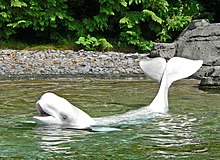
The fins retain the bony vestiges of the beluga's mammalian ancestors, and are firmly bound together by connective tissue.[38] The fins are small in relation to the size of the body, rounded and oar-shaped and slightly curled at the tips.[14] These versatile extremities are mainly used as a rudder to control direction, to work in synchrony with the tailfin and for agile movement in shallow waters up to 3 m (9.8 ft) deep.[37] The fins also contain a mechanism for regulating body temperature, as the arteries feeding the fin's muscles are surrounded by veins that dilate or contract to gain or lose heat.[38][55] The tailfin is flat with two oar-like lobes, it does not have any bones, and is made up of hard, dense, fibrous connective tissue. The tailfin has a distinctive curvature along the lower edge.[38] The longitudinal muscles of the back provide the ascending and descending movement of the tailfin, which has a similar thermoregulation mechanism to the pectoral fins.[38]
Belugas have a dorsal ridge, rather than a dorsal fin.[33] The absence of the dorsal fin is reflected in the genus name of the species—apterus the Greek word for "wingless". The evolutionary preference for a dorsal ridge rather than a fin is believed to be an adaptation to under-ice conditions, or possibly as a way of preserving heat.[12] The crest is hard and, along with the head, can be used to open holes in ice up to 8 cm (3.1 in) thick.[56]
Senses
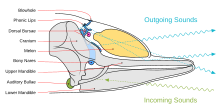
The beluga has a very specialised sense of hearing and its auditory cortex is highly developed. It can hear sounds within the range of 1.2 to 120 kHz, with the greatest sensitivity between 10 and 75 kHz,[57] where the average hearing range for humans is 0.02 to 20 kHz.[58] The majority of sounds are most probably received by the lower jaw and transmitted towards the middle ear. In the toothed whales, the lower jawbone is broad with a cavity at its base, which projects towards the place where it joins the cranium. A fatty deposit inside this small cavity connects to the middle ear.[59] Toothed whales also possess a small external auditory hole a few centimetres behind their eyes; each hole communicates with an external auditory conduit and an eardrum. It is not known if these organs are functional or simply vestigial.[59]
Belugas are able to see within and outside of water, but their vision is relatively poor when compared to dolphins.[60] Their eyes are especially adapted to seeing under water, although when they come into contact with the air, the crystalline lens and the cornea adjust to overcome the associated myopia (the range of vision under water is short).[60] A beluga's retina has cones and rods, which also suggests they can see in low light. The presence of cone cells indicates they can see colours, although this suggestion has not been confirmed.[60] Glands located in the medial corner of their eyes secrete an oily, gelatinous substance that lubricates the eye and helps flush out foreign bodies. This substance forms a film that protects the cornea and the conjunctiva from pathogenic organisms.[60]
Studies on captive animals show they seek frequent physical contact with other belugas.[43] Areas in the mouth have been found that could act as chemoreceptors for different tastes, and they can detect the presence of blood in water, which causes them to react immediately by displaying typical alarm behaviour.[43] Like the other toothed whales, their brains lack olfactory bulbs and olfactory nerves, which suggests they do not have a sense of smell.[45]
Behaviour
Social structure and play
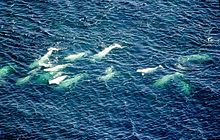
These cetaceans are highly sociable and they regularly form small groups, or pods, that may contain between two and 25 individuals, with an average of 10 members.[61] Pods tend to be unstable, meaning individuals tend to move from pod to pod. Radio tracking has even shown belugas can start out in one pod and within a few days be hundreds of miles away from that pod.[62] Beluga whale pods can be grouped into three categories, nurseries (which consist of mother and calves), bachelors (which consist of all males) and mixed groups. Mixed groups contain animals of both sexes.[63][50] Many hundreds and even thousands of individuals can be present when the pods join in river estuaries during the summer. This can represent a significant proportion of the total population and is when they are most vulnerable to being hunted.[64]
They are cooperative animals and frequently hunt in coordinated groups.[65] The animals in a pod are very sociable and often chase each other as if they are playing or fighting, and they often rub against each other.[66] Often individuals will surface and dive together in a synchronized manner, in a behavior known as milling.
In captivity, they can be seen to be constantly playing, vocalising and swimming around each other.[67] In one case, one whale blew bubbles, while the other one popped them. There have also been reports of beluga whales copying and imitating one another, similar to a game of Simon-says. There have also been reports of them displaying physical affection, via mouth to mouth contact. They also show a great deal of curiosity towards humans and frequently approach the windows in the tanks to observe them.[68]
Belugas also show a great degree of curiosity towards humans in the wild, and frequently swim alongside boats.[69] They also play with objects they find in the water; in the wild, they do this with wood, plants, dead fish and bubbles they have created.[39] During the breeding season, adults have been observed carrying objects such as plants, nets, and even the skeleton of a dead reindeer on their heads and backs.[67] Captive females have also been observed displaying this behavior, carrying items such as floats and buoys, after they have lost a calf. Experts consider this interaction with the objects to be a substitute behavior.[70]
In captivity, mothering behavior among belugas depends on the individual. Some mothers are extremely attentive while other mothers are so blasé, that they have actually lost their calves. In aquaria, there have been cases where dominant females have stolen calves from mothers, particularly if they have lost a calf or if they are pregnant. After giving birth, dominant females will return the calf back to their mother. Additionally, male calves will temporarily leave their mothers to interact with an adult male who can serve as a role model for the calf, before they return to their mothers. Male calves are also frequently seen interacting with each other.
Swimming and diving
Belugas are slower swimmers than the other toothed whales, such as the killer whale and the common bottlenose dolphin, because they are less hydrodynamic and have limited movement of their tail-fins, which produce the greatest thrust.[71] They frequently swim at speeds between 3 and 9 km/h (1.9 and 5.6 mph), although they are able to maintain a speed of 22 km/h for up to 15 min.[50] Unlike most cetaceans, they are capable of swimming backwards.[37][72] Belugas swim on the surface between 5% and 10% of the time, while for the rest of the time they swim at a depth sufficient enough to cover their bodies.[37] They do not jump out of the water like dolphins or killer whales.[14]
These animals usually only dive to depths to 20 m (66 ft),[73] although they are capable of diving to greater depths. Individual captive animals have been recorded at depths between 400 and 647 m below sea level,[74] while animals in the wild have been recorded as diving to a depth of more than 700 m, with the greatest recorded depth being over 900 m.[75] A dive normally lasts 3 to 5 minutes, but can last up to over 20 minutes.[76][50][75][77] In the shallower water of the estuaries, a diving session may last around two minutes; the sequence consists of five or six rapid, shallow dives followed by a deeper dive lasting up to one minute.[37] The average number of dives per day varies between 31 and 51.[75]
All cetaceans, including belugas, have physiological adaptations designed to conserve oxygen while they are under water.[78] During a dive, these animals will reduce their heart rate from 100 beats a minute to between 12 and 20.[78] Blood flow is diverted away from certain tissues and organs and towards the brain, heart and lungs, which require a constant oxygen supply.[78] The amount of oxygen dissolved in the blood is 5.5%, which is greater than that found in land-based mammals and is similar to that of Weddell seals (a diving marine mammal). One study found a female beluga had 16.5 L of oxygen dissolved in her blood.[79] Lastly, the beluga's muscles contain high levels of the protein myoglobin, which stores oxygen in muscle. Myoglobin concentrations in belugas are several times greater than for terrestrial mammals, which help prevent oxygen deficiency during dives.[80]
Beluga whales often accompany bowhead whales, for curiosity and to secure polynya feasibility to breathe as bowheads are capable of breaking through ice from underwater by headbutting.[81]
Diet

Belugas play an important role in the structure and function of marine resources in the Arctic Ocean, as they are the most abundant toothed whales in the region.[82] They are opportunistic feeders; their feeding habits depend on their locations and the season.[32] For example, when they are in the Beaufort Sea, they mainly eat Arctic cod (Boreogadus saida) and the stomachs of belugas caught near Greenland were found to contain rose fish (Sebastes marinus), Greenland halibut (Reinhardtius hippoglossoides) and northern shrimp (Pandalus borealis),[83] while in Alaska their staple diet is Coho salmon (Oncorhynchus kisutch).[84] In general, the diets of these cetaceans consist mainly of fish; apart from those previously mentioned, other fish they feed on include capelin (Mallotus villosus), smelt, sole, flounder, herring, sculpin and other types of salmon.[85] They also consume a great quantity of invertebrates, such as shrimp, squid, crabs, clams, octopus, sea snails, bristle worms and other deep-sea species.[85][86] Belugas feed mainly in winter as their blubber is thickest in later winter and early spring, and thinnest in the fall. Inuit observation has led scientists to believe that belugas do not hunt during migration, at least in Hudson Bay.[87]
The diet of Alaskan belugas is quite diverse and varies depending on season and migratory behavior. Belugas in the Beaufort Sea mainly feed on staghorn and shorthorn sculpin, walleye pollock, Arctic cod, saffron cod and Pacific sand lance. Shrimp are the most common invertebrate eaten, with octopus, amphipods and echiurids being other sources of invertebrate prey. The most common prey species for belugas in the Eastern Chukchi Sea appears to be shrimp, echiurid worms, cephalopods and polychaetes. The largest prey item consumed by beluga whales in the Eastern Chukchi Sea seems to be saffron cod. Beluga whales in the Eastern Bering Sea feed on a variety of fish species including saffron cod, rainbow smelt, walleye pollock, Pacific salmon, Pacific herring and several species of flounder and sculpin. The primary invertebrate consumed is shrimp. The primary prey item in regard to fish species for belugas in Bristol Bay appears to be the five species of salmon, with sockeye being the most prevalent. Smelt is also another common fish family eaten by belugas in this region. Shrimp is the most prevalent invertebrate prey item. The most common prey items for belugas in Cook Inlet appear to be salmon, cod and smelt.[88]
Animals in captivity eat 2.5% to 3.0% of their body weight per day, which equates to 18.2 to 27.2 kg (40 to 60 lb).[89] Like their wild counterparts, captive belugas were found to eat less in the fall.[90]
Foraging on the seabed typically takes place at depths between 20 and 40 m (66 and 131 ft),[91] although they can dive to depths of 700 m (2,300 ft) in search of food.[75] Their flexible necks provide a wide range of movement while they are searching for food on the ocean floor. Some animals have been observed to suck up water and then forcefully expel it to uncover their prey hidden in the silt on the seabed.[65] As their teeth are neither large nor sharp, belugas must use suction to bring their prey into their mouths; it also means their prey has to be consumed whole, which in turn means it cannot be too large or the belugas run the risk of it getting stuck in their throats.[92] They also join into coordinated groups of five or more to feed on shoals of fish by steering the fish into shallow water, where the belugas then attack them.[65] For example, in the estuary of the Amur River, where they mainly feed on salmon, groups of six or eight individuals join to surround a shoal of fish and prevent their escape. Individuals then take turns feeding on the fish.[56]
Reproduction

Estimations of the age of sexual maturity for beluga whales vary considerably; the majority of authors estimate males reach sexual maturity when they are between nine and fifteen years old, and females reach maturity when they are between eight and fourteen years old.[93] The average age at which females first give birth is 8.5 years and fertility begins to decrease when they are 25, eventually undergoing menopause,[94][95] and ceasing reproductive potential with no births recorded for females older than 41.[93] There is a slight difference on the sexual maturation period between males and females. The male beluga whales take seven to nine years to become sexually matured, while the females take four to seven years.[96]
Female belugas typically give birth to one calf every three years.[33] Most mating occurs usually February through May, but some mating occurs at other times of year.[12] The beluga may have delayed implantation.[12] Gestation has been estimated to last 12.0 to 14.5 months,[33] but information derived from captive females suggests a longer gestation period up to 475 days (15.8 months).[97] During the mating season, the testes mass of belugas will double in weight. Testosterone levels increase, but seems to be independent of copulation. Copulation typically takes place between 3 and 4 AM.
Calves are born over a protracted period that varies by location. In the Canadian Arctic, calves are born between March and September, while in Hudson Bay, the peak calving period is in late June, and in Cumberland Sound, most calves are born from late July to early August.[98] Births usually take place in bays or estuaries where the water is warm with a temperature of 10 to 15 °C.[61] Newborns are about 1.5 m (4 ft 11 in) long, weigh about 80 kg (180 lb), and are grey in colour.[50] They are able to swim alongside their mothers immediately after birth.[99] The newborn calves nurse under water and initiate lactation a few hours after birth; thereafter, they feed at intervals around an hour.[65] Studies of captive females have indicated their milk composition varies between individuals and with the stage of lactation; it has an average content of 28% fat, 11% protein, 60.3% water, and less than 1% residual solids.[100] The milk contains about 92 cal per ounce.[101]
The calves remain dependent on their mothers for nursing for the first year, when their teeth appear.[61] After this, they start to supplement their diets with shrimp and small fish.[45] The majority of the calves continue nursing until they are 20 months old, although occasionally lactation can continue for more than two years,[50] and lactational anoestrus may not occur. Alloparenting (care by females different from the mother) has been observed in captive belugas, including spontaneous and long-term milk production. This suggests this behaviour, which is also seen in other mammals, may be present in belugas in the wild.[102]
Hybrids have been documented between the beluga and the narwhal (specifically offspring conceived by a beluga father and a narwhal mother), as one, perhaps even as many as three, such hybrids were killed and harvested during a sustenance hunt. Whether or not these hybrids could breed remains unknown. The unusual dentition seen in the single remaining skull indicates the hybrid hunted on the seabed, much as walruses do, indicating feeding habits different from those of either parent species.[103][104]
Communication and echolocation
Belugas use sounds and echolocation for movement, communication, to find breathing holes in the ice, and to hunt in dark or turbid waters.[46] They produce a rapid sequence of clicks that pass through the melon, which acts as an acoustic lens to focus the sounds into a beam that is projected forward through the surrounding water.[101] These sounds spread through the water at a speed of nearly 1.6 km per second, some four times faster than the speed of sound in air. The sound waves reflect from objects and return as echoes that are heard and interpreted by the animal.[46] This enables them to determine the distance, speed, size, shape and the object's internal structure within the beam of sound. They use this ability when moving around thick Arctic ice sheets, to find areas of unfrozen water for breathing, or air pockets trapped under the ice.[61]
Some evidence indicates that belugas are highly sensitive to noise produced by humans. In one study, the maximum frequencies produced by an individual located in San Diego Bay, California, were between 40 and 60 kHz. The same individual produced sounds with a maximum frequency of 100 to 120 kHz when transferred to Kaneohe Bay in Hawaii. The difference in frequencies is thought to be a response to the difference in environmental noise in the two areas.[105] In special circumstances, beluga whale sounds have been reported to resemble human speech.[106][107]
These animals communicate using sounds of high frequency; their calls can sound like bird songs, so belugas were nicknamed "canaries of the sea".[108] Like the other toothed whales, belugas do not possess vocal cords and the sounds are probably produced by the movement of air between the nasal sacks, which are located near to the blowhole.[46]
Belugas are among the most vocal cetaceans.[109] They use their vocalisations for echolocation, during mating and for communication. They possess a large repertoire, emitting up to 11 different sounds, such as cackles, whistles, trills and squawks.[46] They make sounds by grinding their teeth or splashing, but they rarely use body language.[46]
There is debate as to whether cetacean vocalizations can constitute a language. A study conducted in 2015 determined that European beluga signals share physical features comparable to vowels. These sounds were found to be stable throughout time, but varied among different geographical locations. The further away the populations were from each other, the more varied the sounds were in relation to one another.[110]
Distribution
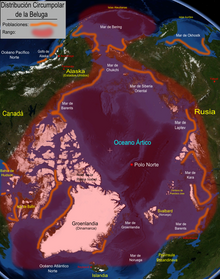
The beluga inhabits a discontinuous circumpolar distribution in Arctic and sub-Arctic waters.[111] During the summer, they can mainly be found in deep waters ranging from 76°N to 80°N, particularly along the coasts of Alaska, northern Canada, western Greenland and northern Russia.[111] The southernmost extent of their range includes isolated populations in the St. Lawrence River in the Atlantic,[112] and the Amur River delta, the Shantar Islands and the waters surrounding Sakhalin Island in the Sea of Okhotsk.[113]
Migration
Belugas have a seasonal migratory pattern.[114] Migration patterns are passed from parents to offspring. Some travel as far as 6,000 kilometres (3,700 mi) per year.[115] When the summer sites become blocked with ice during the autumn, they move to spend the winter in the open sea alongside the pack ice or in areas covered with ice, surviving by using polynyas to surface and breathe.[116] In summer after the sheet ice has melted, they move to coastal areas with shallower water (1–3 m deep), although sometimes they migrate towards deeper waters (deeper than 800 m ).[114] In the summer, they occupy estuaries and the waters of the continental shelf, and, on occasion, they even swim up the rivers.[114] A number of incidents have been reported where groups or individuals have been found hundreds or even thousands of kilometres from the ocean.[117][118] One such example comes from June 9, 2006, when a young beluga carcass was found in the Tanana River near Fairbanks in central Alaska, nearly 1,700 km (1,100 mi) from the nearest ocean habitat. Belugas sometimes follow migrating fish, leading Alaska state biologist Tom Seaton to speculate it had followed migrating salmon up the river at some point in the previous autumn.[119] The rivers they most often travel up include: the Northern Dvina, the Mezen, the Pechora, the Ob and the Yenisei in Asia; the Yukon and the Kuskokwim in Alaska, and the Saint Lawrence in Canada.[111] Spending time in a river has been shown to stimulate an animal's metabolism and facilitates the seasonal renewal of the epidermal layer.[53] In addition, the rivers represent a safe haven for newborn calves where they will not be preyed upon by killer whales.[12] Calves often return to the same estuary as their mother in the summer, meeting her sometimes even after becoming fully mature.[120] However, not all beluga whale populations summer in estuaries. Belugas from the Beaufort Sea stock were found to summer along the Eastern Beaufort Sea shelf, Amundsen Gulf and slope regions north and west of Banks Island, in addition to core areas in the Mackenzie River Estuary. Male belugas have been observed summering in deeper waters along Viscount Melville Sound, in depths of up to 600 metres (2,000 ft). The bulk of Eastern Chukchi Sea belugas summer over Barrow canyon.[121]
The migration season is relatively predictable, as it is basically determined by the amount of daylight and not by other variable physical or biological factors, such as the condition of the sea ice.[122] Vagrants may travel further south to areas such as Irish[123] and Scottish waters,[124] the islands of Orkney[125] and Hebrides,[126] and to Japanese waters.[127] There had been several vagrant individuals[128] that have demonstrated seasonal residencies at Volcano Bay,[129][130][131] and a unique whale were used to return annually to areas adjacent to Shibetsu in Nemuro Strait in the 2000s.[132] On rarer occasions, individuals of vagrancy can reach the Korean Peninsula.[133] A few other individuals have been confirmed to return to the coasts of Hokkaido, and one particular individual became a resident in brackish waters of Lake Notoro since in 2014.[134][135]
Some populations are not migratory and certain resident groups will stay in well-defined areas, such as in Cook Inlet, the estuary of the Saint Lawrence River and Cumberland Sound.[136] The population in Cook Inlet stays in the waters furthest inside the inlet during the summer until the end of autumn. Then during the winter, they disperse to the deeper water in the center of the inlet, but without completely leaving it.[137][138]
In April, the animals that spend the winter in the center and southwest of the Bering Sea move to the north coast of Alaska and the east coast of Russia.[136] The populations living in the Ungava Bay and the eastern and western sides of Hudson Bay overwinter together beneath the sea ice in Hudson Strait. Whales in James Bay that spend winter months within the basin, could be a distinct group from those in Hudson Bay.[139] The populations of the White Sea, the Kara Sea and the Laptev Sea overwinter in the Barents Sea.[136] In the spring, the groups separate and migrate to their respective summer sites.[136]
Habitat

Belugas exploit a varied range of habitats; they are most commonly seen in shallow waters close to the coast, but they have also been reported to live for extended periods in deeper water, where they feed and give birth to their young.[136]
In coastal areas, they can be found in coves, fjords, canals, bays and shallow waters in the Arctic Ocean that are continuously lit by sunlight.[39] They are also often seen during the summer in river estuaries, where they feed, socialize and give birth to young. These waters usually have a temperature between 8 and 10 °C.[39] The mudflats of Cook Inlet in Alaska are a popular location for these animals to spend the first few months of summer.[140] In the eastern Beaufort Sea, female belugas with their young and immature males prefer the open waters close to land, while the adult males live in waters covered by ice near the Canadian Arctic Archipelago. The younger males and females with slightly older young can be found nearer to the ice shelf.[141] Generally, the use of different habitats in summer reflects differences in feeding habits, risk from predators and reproductive factors for each of the subpopulations.[32]
Population
There are currently 22 stocks of beluga whales recognized:[142]
Zdroj:https://en.wikipedia.org?pojem=Beluga_whales
Text je dostupný za podmienok Creative Commons Attribution/Share-Alike License 3.0 Unported; prípadne za ďalších podmienok. Podrobnejšie informácie nájdete na stránke Podmienky použitia.
Antropológia
Aplikované vedy
Bibliometria
Dejiny vedy
Encyklopédie
Filozofia vedy
Forenzné vedy
Humanitné vedy
Knižničná veda
Kryogenika
Kryptológia
Kulturológia
Literárna veda
Medzidisciplinárne oblasti
Metódy kvantitatívnej analýzy
Metavedy
Metodika
Text je dostupný za podmienok Creative
Commons Attribution/Share-Alike License 3.0 Unported; prípadne za ďalších
podmienok.
Podrobnejšie informácie nájdete na stránke Podmienky
použitia.
www.astronomia.sk | www.biologia.sk | www.botanika.sk | www.dejiny.sk | www.economy.sk | www.elektrotechnika.sk | www.estetika.sk | www.farmakologia.sk | www.filozofia.sk | Fyzika | www.futurologia.sk | www.genetika.sk | www.chemia.sk | www.lingvistika.sk | www.politologia.sk | www.psychologia.sk | www.sexuologia.sk | www.sociologia.sk | www.veda.sk I www.zoologia.sk

